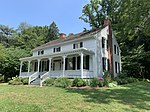Bishop O'Connell High School
1957 establishments in VirginiaCatholic secondary schools in VirginiaEducational institutions established in 1957Roman Catholic Diocese of ArlingtonSchools in Arlington County, Virginia ... and 2 more
Use mdy dates from September 2022Vague or ambiguous time from March 2023

Bishop Denis J. O'Connell High School (also known as DJO) is a Roman Catholic college preparatory school founded in 1957 in Arlington County, Virginia. It was established by the Diocese of Richmond, but it has been under the direction of the Diocese of Arlington since 1974. The school is named for Bishop Denis J. O'Connell, Bishop of Richmond from 1912 to 1926.
Excerpt from the Wikipedia article Bishop O'Connell High School (License: CC BY-SA 3.0, Authors, Images).Bishop O'Connell High School
North Trinidad Street, Arlington
Geographical coordinates (GPS) Address Website External links Nearby Places Show on map
Geographical coordinates (GPS)
| Latitude | Longitude |
|---|---|
| N 38.894753 ° | E -77.161094 ° |
Address
Bishop O'Connell High School
North Trinidad Street
22213 Arlington
Virginia, United States
Open on Google Maps






